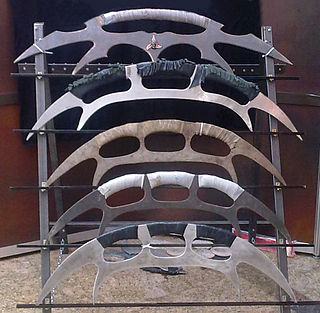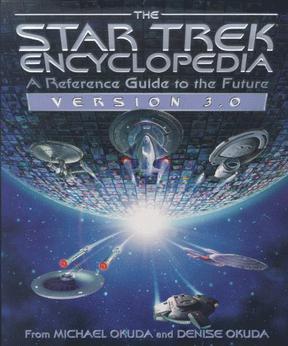
The Ferengi are a fictional extraterrestrial species in the American science fiction franchise Star Trek. They were devised in 1987 for the series Star Trek: The Next Generation, played a prominent role in the following series Star Trek: Deep Space Nine, and have made brief appearances in subsequent series such as Star Trek: Voyager, Star Trek: Enterprise, Star Trek: Discovery, Star Trek: Lower Decks and Star Trek: Picard.

In the Star Trek fictional universe, LCARS is a computer operating system. Within Star Trek chronology, the term was first used in the Star Trek: The Next Generation series.

The bat'leth is a double-sided scimitar/hook sword/lujiaodao hybrid-edged weapon with a curved blade, four points, and three handholds on the back. It was designed and created by Star Trek: The Next Generation visual effects producer Dan Curry for the Star Trek franchise, where it is the characteristic close combat weapon of Klingons. Curry has called the bat'leth "one of the iconic images associated with the show." It has spawned a smaller weapon, which became known as the mek'leth; in Klingon, this is written meqleH. A third weapon, a kur'leth, was later designed by Dan Curry, for Season 3 of Star Trek: Picard. Bat'leths have become an enduring symbol of the franchise among fans, and they are occasionally referenced in other media.

Hikaru Kato Sulu is a fictional character in the Star Trek media franchise. A member of the crew in the original Star Trek series, Sulu also appears in the animated Star Trek series, in the first six Star Trek movies, in one episode of Star Trek: Voyager, and in several books, comics, and video games. Originally known simply as "Sulu", his first name, "Hikaru", appeared in a 1981 novel well over a decade after the original series had ended.

The Star Trek Encyclopedia: A Reference Guide to the Future is a 1994 encyclopedia of in-universe information from the Star Trek television series and films. It was written by Michael Okuda and Denise Okuda, who were production staff on Star Trek: The Next Generation, Star Trek: Deep Space Nine and Star Trek: Voyager and Debbie Mirek. It was illustrated by Doug Drexler.
This article discusses the fictional timeline of the Star Trek franchise. The franchise is primarily set in the future, ranging from the mid-22nd century to the late 24th century, with the third season of Star Trek: Discovery jumping forward to the 32nd century. However the franchise has also outlined a fictional future history of Earth prior to this, and, primarily through time travel plots, explored both past and further-future settings.
Shuttlecraft are fictional vehicles in the Star Trek science fiction franchise built for short trips in space, such as between a planetary surface and orbit. Also referred to as shuttles, their introduction preceded the development of the Space Shuttle.
The Star Trek canon is the set of all material taking place within the Star Trek universe that is considered official. The definition and scope of the Star Trek canon has changed over time. Until late 2006, it was mainly composed of the live-action television series and films before becoming a more vague and abstract concept. From 2010 until 2023, the official Star Trek website's site map described their database, which listed both animated and live-action series and films as its sources, as "The Official Star Trek Canon."

Michael Okuda is an American graphic designer best known for his work on Star Trek including designing futuristic computer user interfaces known as "okudagrams".
Richard Michael Sternbach is an illustrator who is best known for his space illustrations and his work on the Star Trek television series.
"Data's Day" is the 85th episode of the American science fiction television series Star Trek: The Next Generation, the 11th episode of the fourth season. This episode introduces both Keiko O'Brien and Data's pet cat, Spot.
Jeri Taylor is a television scriptwriter and producer, who wrote many episodes of the Star Trek: The Next Generation and Star Trek: Voyager series.

Doug Drexler is an Oscar winning visual effects artist, designer, sculptor, illustrator, and a makeup artist who has collaborated with such talents as Al Pacino, Dustin Hoffman, James Caan, Meryl Streep, and Warren Beatty. He began his career in the entertainment industry working for makeup artist Dick Smith on such films as The Hunger and Starman. He has also contributed to Three Men and a Little Lady, The Cotton Club, FX, Manhunter and Dick Tracy. Dick Tracy earned Drexler an Oscar, as well as The British Academy Award and the Saturn Award for his special makeup effects on characters such as Big Boy Caprice and Mumbles. Two Emmy nominations in the same field followed for three years working on Star Trek: The Next Generation, where he performed such tasks as aging Captain Picard for "The Inner Light". His final make-up job for the series was the Mark Twain makeup worn by Jerry Hardin in the two part episode "Times Arrow"
The Star Trek franchise features many spacecraft. Various space vessels make up the primary settings of the Star Trek television series, films, and expanded universe; others help advance the franchise's stories. Throughout the franchise's production, spacecraft have been depicted by numerous physical and computer-generated models. Producers worked to balance often tight budgets with the need to depict convincing, futuristic vessels.

Star Trek: Picard is an American science fiction television series created by Akiva Goldsman, Michael Chabon, Kirsten Beyer, and Alex Kurtzman for the streaming service CBS All Access. It is the eighth Star Trek series and was released from 2020 to 2023 as part of Kurtzman's expanded Star Trek Universe. The series focuses on retired Starfleet Admiral Jean-Luc Picard. It begins at the end of the 24th century, 20 years after the character's last appearance in Star Trek: Nemesis (2002).

Terry Matalas is an American television writer, director, and executive producer, best known for co-creating and showrunning 12 Monkeys (2015–18), which ran for four seasons on SyFy. He was a showrunner on the fourth season of MacGyver for CBS (2020) and the second and third seasons of Star Trek: Picard on Paramount+ (2022–23).

The second season of the American television series Star Trek: Picard features the character Jean-Luc Picard in the year 2401. He and his companions are trapped in an alternate reality by the extra-dimensional being Q as part of the ultimate trial for Picard, and must travel back to 2024 Los Angeles to save the future of the galaxy. The season was produced by CBS Studios in association with Secret Hideout, Weed Road Pictures, and Roddenberry Entertainment, with Akiva Goldsman and Terry Matalas serving as showrunners.

The third and final season of the American television series Star Trek: Picard features the character Jean-Luc Picard in the year 2401 as he reunites with the former command crew of the USS Enterprise while facing a mysterious enemy who is hunting Picard's son. The season was produced by CBS Studios in association with Secret Hideout, Weed Road Pictures, and Roddenberry Entertainment, with Terry Matalas serving as showrunner.











